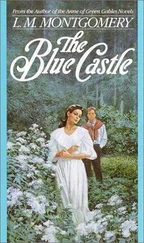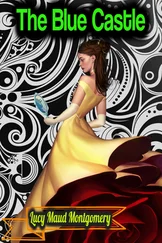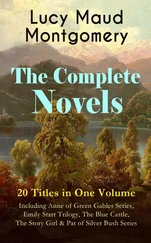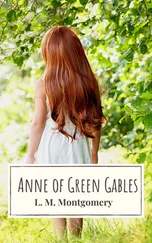The hotel is in a lovely spot, on the shore of Loch Achray.
"Where shall we find in foreign land
So lone a lake, so sweet a strand?"
Yet Loch Achray, too, was on a smaller scale than I had expected. We walked along it that night as far as the 'Brig of Turk,' gathering bell-heather and bluebells as we went. Scottish bluebells are certainly the sweetest things! They seem the very incarnation of old Scotia's romance.
Next morning we walked through the Trossachs to Loch Katrine in a pouring rain and hired one of the boatmen to row us to and around "Ellen's Isle." I don't think I liked it because it, too, was not the islet of my dream, and I was conscious of a foolish disappointment.
Ben Venue, however, did not disappoint me. It dominates the landscape. Everywhere we went, there was old Ben Venue, rugged and massive, with a cloud-wreath resting on his 'summit hoar.' I was very sorry that the night we spent there was wet. I should have loved to have seen a sunset effect on Ben Venue.
August 6, 1912
Last Monday morning we went by train to Melrose and coached over six miles of most beautiful road to Abbotsford. Although we went on our own account we could not help falling in with a Cook excursion and this somewhat spoiled the day for us. But the scenery along the road is exquisite and we saw the Eildon Hills, cleft in three by the spells of wizardry. Abbotsford is most interesting, crowded with relics I should have loved to have dreamed over in solitude. But that might not be. The rooms were filled by a chattering crowd, harangued by a glib guide. I wondered if Scott would have liked to think of his home being so over-run by a horde of curious sight-seers.
We drove from Abbotsford to Dryburgh where Scott is buried. As we were able to escape from the "Cookies" here we enjoyed the magnificent ruin doubly. Then we returned to Melrose and explored the ruins of the Abbey there. We could not follow Scott's advice, which I never believed he failed, as is asserted, to take himself, and view it by moonlight. But in that mellow, golden-gray evening light it was beautiful enough, beautiful and sad, with the little bluebells growing in its ruined courts and over its old graves. Michael Scott is reputed to be buried there, and there the heart of Robert Bruce was buried, and doubtless, rests as quietly as though it had, according to his wish, been laid in the soil of the Holy Land.
There is some wonderful hand-carving still left in Melrose, and the little hand high up on one of the arches is as suggestive as it is beautiful. What fair lady's hand was chiselled there in lasting stone? One cannot but think it was wrought by a lover. On Wednesday we left for Inverness, but stopped off en route to visit Kirriemuir, the "Thrums" of Barrie's stories. In particular, I wanted to see the 'Den' where Sentimental Tommy and his cronies held their delightful revels. It is a lovely spot. One thing about it made me feel at home, its paths, which Barrie calls 'pink,' are the very red of our own island roads. I could have fancied that I was prowling in the woods around Lovers' Lane.
Of all the places we have visited in Scotland thus far I like Inverness best. In itself it is only a small gray town but the surrounding scenery is magnificent.
We drove out to Culloden the evening of our arrival and it is one of the drives that, for sheer pleasure, will always stand out in my memory. The road was exceedingly lovely and we were fortunate enough to have a nice old driver who knew all the history and legend of everything, and was very willing to tell it in delightful broad Scotch.
The next day we visited Tomnahurich, the famous cemetery of Inverness. It deserves its fame; I am sure it must be the most beautiful cemetery in the world. It is a large hill outside the city, rising in a perfect cone, and thickly covered with trees. The name is a Gaelic word meaning 'the hill of the fairies,' and surely it must once have been a spot meet for a fairy kingdom and the revels of Titania. Seen at eventide, against a sunset sky, it seems a veritable outpost of the Land of Old Romance.
We returned by way of the Caledonian Canal to Fort William, and thence by train. The sunset effects on the mountains along our way were wonderful. If I were to live near mountains for any length of time I should learn to love them almost as much as I love the sea.
August 13, 1912
Last Monday we visited Roslin Chapel, a wonderful specimen of Gothic work in perfect preservation. This is the chapel of Scott's ballad, "Fair Rosabelle":
"Seemed all on fire that chapel proud
Where Roslin's chiefs uncoffined lie."
Wednesday we left Edinburgh and went to Alloa to visit friends. Thursday we 'did' Dollar Glen. I had never heard of this place until Mr. M. of Alloa told us of it, yet it is one of the wildest, grandest spots we have seen in all Scotland. If Scott had touched it with his genius it would be as widely known as the Trossachs. Indeed, it is much what I had imagined the Trossachs to be. Dollar Glen is like a deep gash cleft down through the heart of the mountain.
Stirling and Abbey Craig on Friday, places steeped with romance. Yesterday we came to Berwick to spend a week in the Marmion country. Mr. M. and Miss A. came with us. Berwick is a most quaint, antiquated old town. As we live on the Spittal side, when we want to go anywhere we have to be rowed over the river mouth by one of the half-dozen quaint old ferrymen who have boats for hire. Last night we all went for a walk along the Spittal shore by moonlight. It was beautiful but so like the Cavendish shore that it made me bitterly homesick.
Carlisle, August 20
We are spending Sunday in Carlisle perforce, since we could not get any farther last night, owing to the big railway strike which has been paralysing Britain this past week. At Berwick we did not suffer from it, nor heed it. We let the outer world go by and lived in realms of romance where ferry boats and shank's mare were the only desired means of locomotion.
Last Monday we went to Holy Island and explored the ruins of the old Abbey which was the scene of Constance de Beverley's death in Marmion. We had an enjoyable sail down to Holy Island but the return home was sadly different. It was quite rough and how that wretched little steamer pitched and rolled! Both our gentlemen became so overcome that they had to retire temporarily from the scene, while Miss A. and I fought off surrender only by a tremendous effort of will and would have suffered less I think if we had just allowed ourselves to go!
Luckily seasickness is never fatal and next day we were all ready for an excursion to Norham Castle, a very ruinous ruin.
Growing all over the grounds was a little blue flower which I never saw anywhere else save in the front orchard of the old home in Cavendish. Great-grandmother Woolner had brought it out from England with her. It gave me an odd feeling of pain and pleasure mingled, to find it growing there around that old ruined Scottish castle which seemed to belong so utterly to another time and another order of things. We walked from Norham to Ladykirk and then back by the Tweed. When we grew tired we sat down on its bank and dreamed dreams. What meeter place could there be for dreaming than the twilit banks of Tweed?
Next day we went to Flodden Field. It disappointed me unreasonably, it was all so peaceful, and harvest-hued, and agricultural. I felt as aggrieved as though I had had any right to expect to see a mediaeval battle being fought under my eyes.
Thursday afternoon we had a delightful little expedition to Homecliffe Glen and its deserted old mill. It might serve as a scene for a ghost story. In the midst of the ravine we came upon a clump of spruce trees literally loaded with gum, the first I had seen since leaving home. Spruce gum and the delights of picking it seem quite unknown in Scotland. We spent a half-hour picking it. To me and my husband the gum tasted delicious, but neither Mr. M. nor Miss A. liked its flavor declaring it was 'bitter'.
Читать дальше





